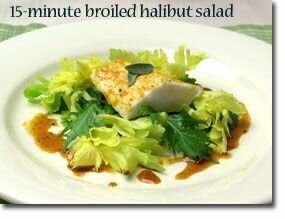healthy food tip and recipe
Today's Recipe
If you don't know what to serve for dinner tonight ...
This is a great recipe to help add more omega-3 fatty acids to your meal. The halibut in this easy-to-prepare salad provides you with one-third (32%) of the daily value for this important nutrient. Combined with the salad greens, you get a wide range of nutrients that will work together synergistically towards optimal health. Enjoy!

Ingredients:
- 4 medium cloves garlic, pressed
- 1/2 lb mixed salad greens
- 4 - 6 oz halibut steaks or fillets
- 1 TBS + 1/4 cup fresh lemon juice
- salt and cracked black pepper to taste
- 1 cup vegetable broth
- 3 TBS fresh chopped sage (or 3 tsp dried sage)
- *optional 3 TBS extra virgin olive oil
- Press garlic and let it sit for 5 minutes to bring out its health-promoting properties.
- Rinse and dry salad greens by using salad spinner if possible. Place greens mixture on 4 plates.
- Rub halibut with 1 TBS lemon juice and season with a little salt and pepper.
- Heat broth and add halibut; cover and cook for 10 minutes for each inch of thickness.
- Remove fish from pan and place on salad greens.
- Discard extra broth or use for soup. In same pan add garlic, sage and 1/4 cup lemon juice to hot pan and heat for about 30 seconds.
- If you'd like to add olive oil, do so after turning off heat. Stir mixture together for a few seconds and then drizzle over salad. Season with salt and cracked black pepper.
In-Depth Nutritional Profile for 15-Minute Halibut Salad
Healthy Food Tip
I have a latex allergy and was recently told that avocados and latex are somehow related. Can you clarify this for me?
Between 30-50% of individuals who have allergies to latex may also have allergic reactions to certain plant foods including avocados, bananas, mangos, papayas, and chestnuts. Currently, the most conclusive evidence suggests that foods most likely to cross-react with latex are uncooked foods containing enzymes called chitinases, which have some similar protein structures to the proteins found in latex. I use the qualifier "uncooked" here because some evidence suggests that the cooked forms of these foods may be acceptable since cooking can bring about changes in the structure of the food's chitinase enzymes. Legumes, for example, also contain chitinase enzymes but are seldom involved in latex food allergy, presumably because they are rarely eaten uncooked.

No comments:
Post a Comment